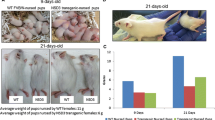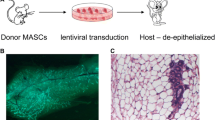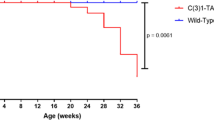Abstract
Transgenic mice expressing c-myc and v-Ha-ras specifically in the mammary gland under the control of the mammary specific promoter MMTV develop unifocal mammary tumors with a half time of about 46 days, and these tumors express high levels of osteopontin mRNA and protein. In order to evaluate the requirement for osteopontin expression by these tumors, we have crossed transgenic mice expressing these two oncogenes with mice with a targeted disruption of the osteopontin gene. Littermates expressing both myc and ras, and with either wild-type or disrupted OPN alleles were evaluated for tumor incidence and growth rate. Both of these parameters were found to be unaffected by a lack of osteopontin in the whole animal. Ras and myc expression level, measured at the level of mRNA, was not different in tumors of the two genotypes. Macrophage accumulation, while extremely variable among different tumors, did not correlate with the OPN status of the animals. Expression of the related gene BSP was not detected in any of the tumors, and was similar in bones of wildtype and OPN –/– mice. Similarly, the vitronectin gene was expressed at very low levels in tumors of either genotype. These results indicate that despite its high level of expression, OPN is either not required for mammary primary tumor formation and growth in this system, or can be replaced by molecules other than BSP and vitronectin in mice that totally lack osteopontin.
Similar content being viewed by others
References
Denhardt DT, Noda M: Osteopontin expression and function: role in bone remodeling. J Cell Biochem S30/31, 92-102, 1998
Smith LL, Cheung HK, Ling LE, Chen J, Sheppard D, Pytela R, Giachelli CM: Osteopontin N-terminal domain contains a cryptic adhesive sequence recognized by a9b1 integrin. J Biol Chem 271: 28485-28491, 1996
Yokosaki Y, Matsuura N, Sasaki T, Murakami I, Schneider H, Higashiyama S, Saitoh Y, Yamakido M, Taooka Y, Sheppard D: The integrin alpha(9)beta(1) binds to a novel recognition sequence (SVVYGLR) in the thrombin-cleaved amino-terminal fragment of osteopontin. J Biol Chem 274: 36328-36334, 1999
van Dijk S, D'Errico JA, Somerman MJ, Farach-Carson MC, Butler WT: Evidence that a non-RGD domain in rat osteopontin is involved in cell attachment. J Bone Miner Res 8: 1499-1506, 1993
Katagiri YU, Murakami M, Mori K, Iizuka J, Hara T, Tanaka K, Jia WY, Chambers AF, Uede T: Non-RGD domains of osteopontin promote cell adhesion without involving alpha v integrins. J Cell Biochem 62: 123-131, 1996
Katagiri YU, Sleeman J, Fujii H, Herrlich P, Hotta H, Tanaka K, Chikuma S, Yagita H, Okumura K, Murakami M, Saiki I, Chambers AF, Uede T: CD44 variants but not CD44s cooperate with beta1-containing integrins to permit cells to bind to osteopontin independently of arginine-glycine-aspartic acid, thereby stimulating cell motility and chemotaxis. Cancer Res 59: 219-226, 1999
Weber GF, Ashkar S, Glimcher MJ, Cantor H. Receptor-ligand interaction between CD44 and osteopontin (ETA-1). Science 271: 509-512, 1996
Butler WT, Ridall AL, McKee MD: Osteopontin. In: Bilezikian JP, Raisz LG, Rodan GA, (eds) Principles in bone biology. San Diego: Academic Press, 1996, p. 167-181
Rittling SR, Matsumoto HN, McKee MD, Nanci A, An XR, Novick KE, Kowalski AJ, Noda M, Denhardt DT: Mice lacking osteopontin show normal development and bone structure but display altered osteoclast formation in vitro. J Bone Min Res 13: 1101-1111, 1998
Liaw L, Birk DE, Ballas CB, Whitsitt JS, Davidson JM, Hogan BLM: Altered wound healing in mice lacking a functional osteopontin gene (spp1). J Clin Invest 101: 1468-1478, 1998
Rittling SR, Denhardt DT: Osteopontin (OPN) function in pathology: lessons from OPN-deficient mice. Experimental Nephrology 7: 103-113, 1999
Senger DR, Perruzzi CA, Gracey CF, Papadopoulous A, Tenen DG: Secreted phosphoproteins associated with neoplastic transformation: close homology with plasma proteins cleaved during blood coagulation. Cancer Res 48: 5770-5774, 1988
Senger DR, Perruzzi CA, Papadopoulous A: Elevated expression of secreted phosphoprotein I (osteopontin, 2ar) as a consequence of neoplastic transformation. Anticancer Res 9: 1291-1300, 1989
Chambers AF, Behrend EI, Wilson SM, Denhardt DT: Induction of expression of osteopontin (OPN, secreted phosphoprotein) in metastatic, ras-transformed NIH-3T3 cells. Anticancer Res 12: 43-48, 1992
Guo X, Zhang YP, Mitchell DA, Denhardt DT, Chambers AF: Identification of a ras-activated enhancer in the mouse osteopontin promoter and its interaction with a putative ETSrelated transcription factor whose activity correlates with the metastatic potential of the cell. Mol Cell Bio 15: 476-487, 1995
Morris VL, Tuck AB, Wilson SM, Percy D, Chambers AF: Tumor progression and metastasis in murine D2 hyperplastic alveolar nodule mammary tumor cell lines. Clin Exp Metastasis 11: 103-112, 1993
Behrend EI, Craig AM, Wilson SM, Denhardt DT, Chambers AF: Reduced malignancy of ras-transformed NIH 3T3 cells expressing antisense osteopontin RNA. Cancer Res 54: 832-837, 1994
Gardner HAR, Berse B, Senger DR: Specific reduction in osteopontin synthesis by antisense RNA inhibits the tumorigenicity of transformed Rat1 fibroblasts. Oncogene 9: 2321-2326, 1994
Su L, Mukherjee AB, Mukherjee BB: Expression of antisense osteopontin mRNA inhibits tumor promoter-induced neoplastic transformation of mouse JB6 epidermal cells. Oncogene 10: 2163-2169, 1995
Feng B, Rollo EE, Denhardt DT: Osteopontin (OPN) may facilitate metastasis by protecting cells from macrophage NO-mediated cytotoxicity: evidence from cell lines downregulated for OPN expression. Clin Exptl Metastasis 13: 453-462, 1995
Oates AJ, Barraclough R, Rudland PS: Enhanced expression of the osteopontin gene in metastatic rat mammary epithelialderived cell lines. Oncogene 97-104, 1996
Chen H, Ke Y, Oates AJ, Barraclough R, Rudland PS: Isolation of and effector for metastasis-inducing DNAs from a human metastatic carcinoma cell line. Oncogene 14: 1581-1588, 1997
Yoneda T, Williams PJ, Niewolna M: Promotion of angiogenesis and enhancement of breast cancer metastasis to bone. Bone 23: S201, 1998
Rittling SR, Novick KW: Osteopontin expression in mammary gland development and tumorigenesis. Cell Growth Differ 8: 1061-1069, 1997
Brown LF, Papadopoulous-Sergiou A, Berse B, Manseau EJ, Tognazzi K, Perruzzi CA, Dvorak HF, Senger DR: Osteopontin expression and distribution in human carcinomas. Am J Pathol 145: 610-623, 1994
Sung V, Gilles C, Murray A, Clarke R, Aaron AD, Azumi N, Thompson EW: The LCC-15 MB human breast cancer cell line expresses osteopontin and exhibits an invasive and metastatic phenotype. Exptl Cell Res 241: 273-284, 1998
Tuck AB, O'Malley FP, Singhal H, Tonkin KS, Kerkvliet N, Saad Z, Doig GS, Chambers AF: Osteopontin expression in a group of lymph node negative breast cancer patients. Int J Cancer 79: 502-508, 1998
Sinn E, Muller WJ, Pattengale PK, Tepler I, Wallace R, Leder P: Coexpression ofMMTV/v-Ha-ras andMMTV-c-myc genes in transgenic mice: synergistic action of oncogenes in vivo. Cell 49: 465-475, 1987
Pattengale PK, Stewart TA, Leder A, Sinn E, Tepler I, Schmidt E, Leder P: Animal models of human disease. Am J Pathol 135: 39-61, 1989
Young MF, Ibaraki K, Kerr JM, Lyu MS, Kozak CA: Murine bone sialoprotein (BSP): cDNA cloning, mRNA expression and genetic mapping. Mamm Genome 5: 108-111, 1994
Rittling SR, Feng F: Detection of mouse osteopontin by western blotting. Biochem Biophys Res Comm 250: 287-292, 1998
Liaw L, Almeida M, Hart CE, Schwartz SM, Giachelli CM: Osteopontin promotes vascular cell adhesion and spreading and is chemotactic for smooth muscle cells in vitro. Circ Res 74: 214-224, 1994
Austyn JM, Gordon S: F4/80, a monoclonal antibody directed specifically against the mouse macrophage. Eur J Immunol 11: 805-815, 1981
Singh RP, Patarca R, Schwartz J, Singh P, Cantor H: Definition of a specific interaction between the early T lymphocyte activation 1 (Eta-1) protein and murine macrophages in vitro and its effect upon macrophages in vivo. J Exp Med 171: 1931-1942, 1990
Giachelli CM, Lombardi D, Johnson RJ, Murry CE, Almeida M: Evidence for a role of osteopontin in macrophage infiltration in response to pathological stimuli in vivo. Am J Pathol 152: 353-358, 1998
Fisher LW, McBride OW, Termine JD, Young MF: Human bone sialoprotein. Deduced protein sequence and chromosomal localization. J Biol Chem 265: 2347-2351, 1990
Bellahcene A, Antoine N, Clausse N, Tagliabue E, Fisher LW, Kerr JM, Jares P, Castronovo V: Detection of bone sialoprotein in human breast cancer tissue and cell lines at both protein and messenger ribonucleic acid levels. Lab Invest 75: 203-210, 1996
Sharp JA, Sung V, Slavin J, Thompson EW, Henderson MA: Tumor cells are the source of osteopontin and bone sialoprotein expression in human breast cancer. Lab Invest 79: 869-877, 1999
Nip J, Shibata H, Loskutoff DJ, Cheresh DA, Brodt P: Human melanoma cells derived from lymphatic metastases use integrin alpha v beta 3 to adhere to lymph node vitronectin. J Clin Invest 90: 1406-1413, 1992
Crawford HC, Matrisian LM, Liaw L: Distinct roles of osteopontin in host defense activity and tumor survival during squamous cell carcinoma progression in vivo. Cancer Res 58: 5206-5215, 1998
Talts JF, Wirl G, Dictor M, Muller WJ, Fassler R: Tenascin-C modulates tumor stroma and monocyte/macrophage recruitment but not tumor growth or metastasis in a mouse strain with spontaneous mammary cancer. J Cell Sci 112 (Pt 12): 1855-1864, 1999
Wu YM, Denhardt DT, Rittling SR: Osteopontin is required for full expression of the transformed phenotype by the ras oncogene. British J Cancer 83: 156-163, 2000
Hynes RO: Integrins: versatility, modulation, and signaling in cell adhesion. Cell 69: 11-25, 1992
Tuck AB, Arsenault DM, O'Malley FP, Hota C, Ling MC, Wilson SM, Chambers AF: Osteopontin induces increased invasiveness and plasminogen activator expression of human mammary epithelial cells. Oncogene 18: 4237-4246, 1999
Mukaida N, Harada A, Matsushima K: Interleukin-8 (IL-8) and monocyte chemotactic and activating factor (MCAF/MCP-1), chemokines essentially involved in inflammatory and immune reactions. Cytokine Growth Factor Rev 9: 9-23, 1998
Pan H, Yin C, Dyson NJ, Harlow E, Yamasaki L, Van Dyke T: Key roles for E2F1 in signaling p53-dependent apoptosis and in cell division within developing tumors. Mol Cell 2: 283-292, 1998
Crosby AH, Lyu MS, Lin K, McBride OW, Kerr JM, Aplin HM, Fisher LW, Young MF, Kozak CA, Dixon MJ: Mapping of the human and mouse bone sialoprotein and osteopontin loci. Mamm Genome 7: 149-151, 1996
Bianco P, Fisher LW, Young MF, Termine JD, Robey PG: Expression of bone sialoprotein (BSP) in developing human tissues. Calcif Tissue Int 49: 421-426, 1991
Schvartz I, Seger D, Shaltiel S. Vitronectin: Int J Biochem Cell Biol 31: 539-544, 1999
Seiffert D: Constitutive and regulated expression of vitronectin. Histol Histopathol 12: 787-797, 1997
Author information
Authors and Affiliations
Rights and permissions
About this article
Cite this article
Feng, F., Rittling, S.R. Mammary tumor development in MMTV-c-myc/MMTV-v-Ha-ras transgenic mice is unaffected by osteopontin deficiency. Breast Cancer Res Treat 63, 71–79 (2000). https://doi.org/10.1023/A:1006466516192
Issue Date:
DOI: https://doi.org/10.1023/A:1006466516192




